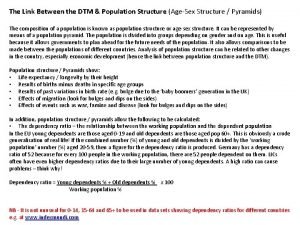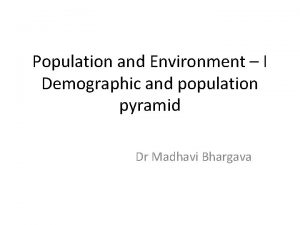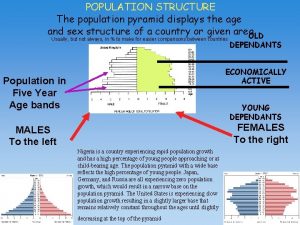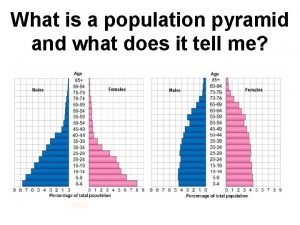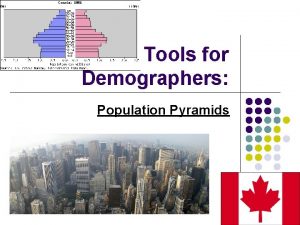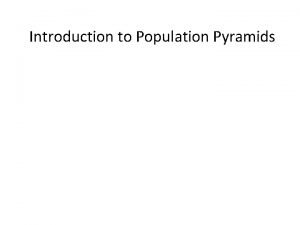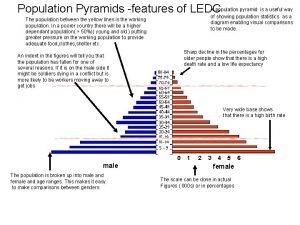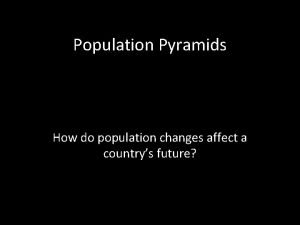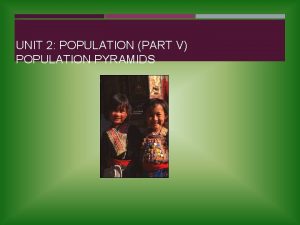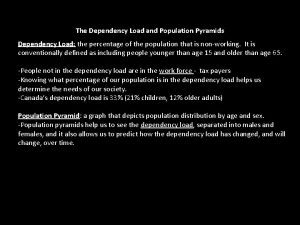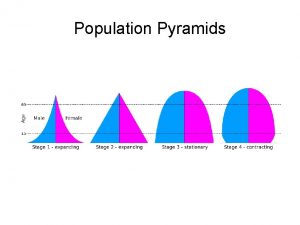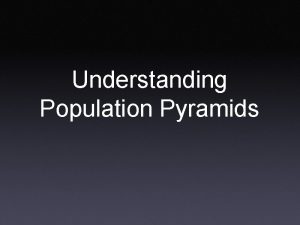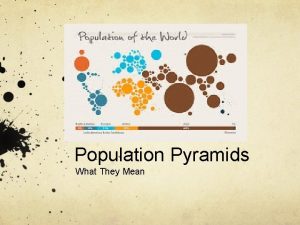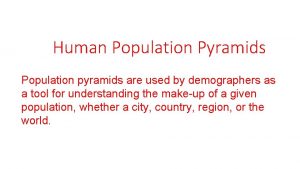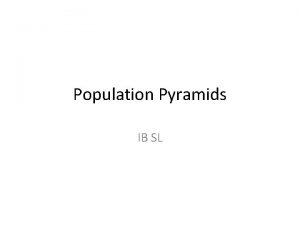Unit 1 Population Part V Population pyramids Dependency


















- Slides: 18

Unit 1: Population (Part V) Population pyramids

Dependency Ratio The number of people who are too young or too old to work, compared to the number of people in their productive years

Dependency Ratio 0 -14 = Dependents 15 -64 = Workers 65+ = Dependents DR = Number of Dependents (0 -14 and 65+) Number of Working-age (15 -64) X 100

FPopulation under the age of 15 - usually shown as a percentage of the total population of a country - dependency age is 0 -15

FThe Ageing World

Gender Ratio Gender (Sex) Ratio: number of males per hundred females In general more males are born than females Males have higher death rates Examples: Europe and North America = 95: 100 Rest of World = 102: 100

Ratio – Developing Countries Gender Have large % of young people – where males generally outnumber females Lower % of older people – where females are typically more numerous High immigration = more males

Population Pyramids A country’s stage in Demographic Transition gives it a distinctive population structure Also called Age/Sex Pyramids Population composition on graph: Males = left side of the vertical axis Females = right side of the vertical axis Age = order sequentially with youngest at the bottom and oldest at the top (usually by five-year cohorts)

5 Stages of DTM relative to Population Pyramids

Population Structure Poor Countries (Stage 2) Rich Countries (Stage 4) A wide base is the result of a high Narrow base due to CBR decreasing/low CBR A narrow apex shows relatively low life expectancy Big decreases upwards on pyramid indicate high CDR Apex that gradually tapers upwards shows low CDRs and long life expectancy High percentage of the population is near age of 65

Problems Caused by Different Population Structures More Economically Developed Countries -increased ageing population causes stagnation and population decline. Increased burden on economically active. Leads to closure of schools and maternity wards. May possibly raise the retirement age and tax rates to compensate for the lack of economically active people. Less Economically Developed Countries-high percentage of young dependents means more money is spent on childcare, education, schools cannot cope, therefore girls are less likely to be educated, leading to high CBR. Unemployment increases because the number of jobs cannot keep up with population increase.

Population Pyramid Summary for United States: 1950, 2025, 2050 Population Pyramid Summary for United States: 1950, 2025, 2050

Population Pyramids Summary for India: 2000, 2050, 2100

One “weird” pyramid-Bahrain (middle east) 2020

Population Woes for East Asia: Japan 1970 s-BR 2. 1/2015 -BR 1. 0 Japanese are living longer Highest proportion of elderly in the world Currently 20% of population is over 65 By 2040 -40% will be over 65 WHAT WILL THEIR FUTURE PYRAMID RESEMBLE? Here you go…

Population Woes for East Asia: China’s past, present and future China (1/5 th of the world’s population)-1. 36 billion One-Child Policy-implemented in 1979, prevented over 400 million births. Reduced TFR from 5. 3 to 1. 5 Fall in fertility rates due to improving economic and social factors in urban areas Late-term abortions encouraged Baby girls sold for average of $3, 000/baby Couples are fined $3, 000 per additional child beyond one in urban areas Rural families were allowed to have two children if first was a girl China now has one of the oldest populations in the world-30% over 50 yrs. old WHAT WILL THEIR FUTURE PYRAMID RESEMBLE?

China

The End of the “pyramid” (for developed countries) http: //www. economist. com/blogs/graphicdetail/2014/11/daily-chart-10
 Ann arbor mi population pyramid
Ann arbor mi population pyramid Stable age structure diagram
Stable age structure diagram How to read population pyramids
How to read population pyramids Broad based pyramid shaped age structure
Broad based pyramid shaped age structure Population pyramid types
Population pyramid types Beehive shaped population pyramid
Beehive shaped population pyramid Demographic transition model population pyramids
Demographic transition model population pyramids Why do geographers use population pyramids
Why do geographers use population pyramids Population pyramids
Population pyramids Population pyramids definition
Population pyramids definition Population pyramids
Population pyramids Population pyramids
Population pyramids Japan population pyramid
Japan population pyramid Population pyramids
Population pyramids Population pyramids
Population pyramids Analyzing population pyramids
Analyzing population pyramids Idb population pyramids
Idb population pyramids Unit 10, unit 10 review tests, unit 10 general test
Unit 10, unit 10 review tests, unit 10 general test Chapter 4 population ecology answer key
Chapter 4 population ecology answer key

